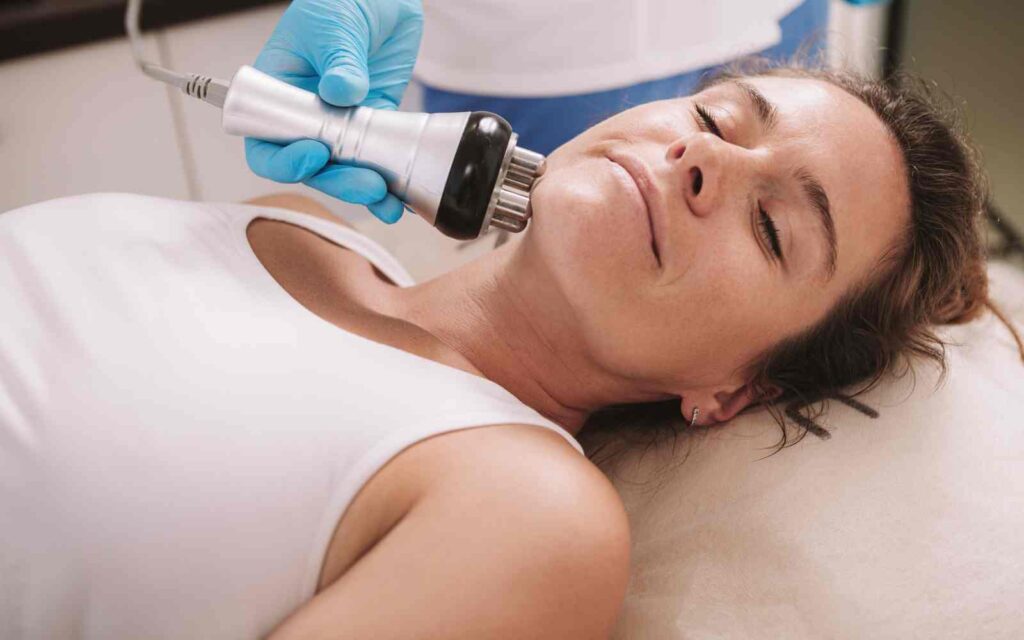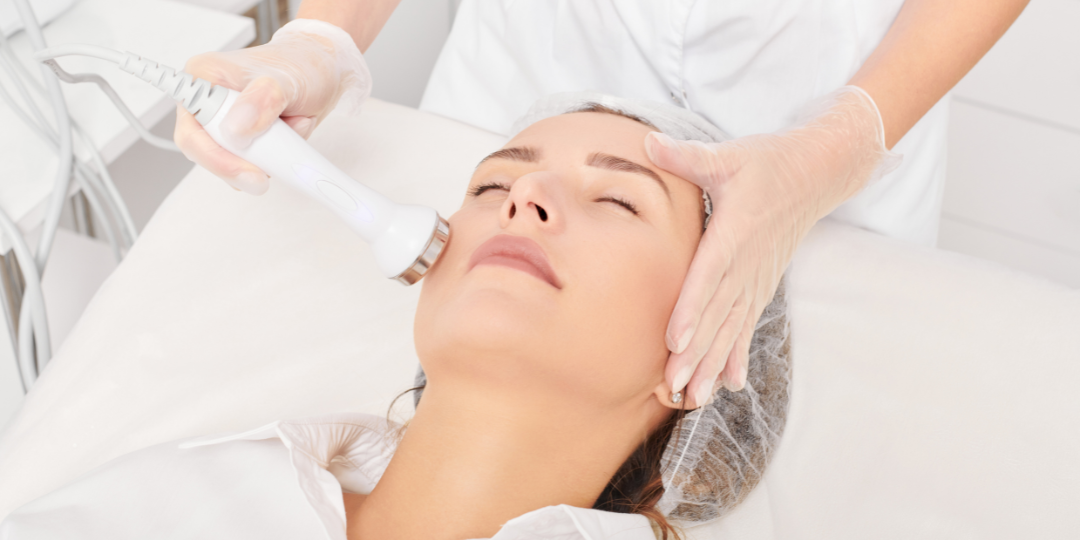
Introduction
Ultrasonic cavitation is rapidly emerging as a groundbreaking solution in the realm of non-invasive facial rejuvenation, revolutionizing how we approach skincare and beauty. This innovative technique harnesses the power of ultrasonic waves to target and transform the skin at a cellular level, offering a unique alternative to traditional surgical methods. Its growing popularity stems from its ability to deliver significant results without the need for invasive procedures, aligning perfectly with the modern desire for efficient and minimal-downtime beauty treatments.
In this evolving landscape of aesthetic medicine, ultrasonic cavitation stands out for its ability to blend science and technology to offer a safer, yet highly effective, approach to facial rejuvenation. It’s not just about looking good; it’s about fostering skin health and confidence without the risks associated with surgery.
The purpose of this blog is to delve deep into the three transformative benefits of ultrasonic cavitation. We will explore how this state-of-the-art technology can enhance collagen production, reduce fine lines and wrinkles, and improve overall skin tone and texture. Whether you’re a skincare enthusiast, someone curious about non-invasive cosmetic treatments, or seeking alternatives to traditional facial rejuvenation methods, this post will provide you with valuable insights into the revolutionary world of ultrasonic cavitation. Join us as we uncover the science, the results, and the potential of this remarkable treatment in transforming not just your skin, but also your perception of modern skincare.
Table of Contents
What is Non-invasive Facial Rejuvenation Ultrasonic Cavitation?
Ultrasonic cavitation is a cutting-edge cosmetic treatment, increasingly hailed for its efficacy in facial rejuvenation without the invasiveness of traditional surgery. At its core, ultrasonic cavitation involves the use of low-frequency sound waves to create micro-bubbles in the skin’s tissue. These sound waves, imperceptible to the human ear, are potent enough to cause a vibrational effect in the targeted area.
How does this technology work on the skin? When the ultrasonic waves are directed towards the facial tissues, they create oscillating pressure. This pressure leads to the formation of micro-bubbles or cavities in the fluid between the cells. These bubbles then collapse or implode, releasing energy. This energy release, while gentle and non-destructive to the surrounding tissues, is powerful enough to stimulate various responses in the skin.
The science behind ultrasonic waves and their effects on facial tissue is fascinating. The implosion of these micro-bubbles stimulates the skin’s natural repair mechanisms. This process initiates a series of responses, including increased circulation, collagen production, and lymphatic drainage. Collagen, a vital protein in our skin, is responsible for its firmness and elasticity. By boosting collagen production, ultrasonic cavitation aids in reducing the appearance of fine lines and sagging skin, leading to a more youthful and refreshed appearance.
Moreover, this technology helps in detoxifying the facial skin. The improved lymphatic drainage removes toxins and reduces water retention, contributing to a clearer, more even-toned complexion. This aspect is particularly beneficial for individuals who experience puffiness or under-eye bags.
In essence, ultrasonic cavitation is a remarkable blend of physics and biology, utilizing sound waves to encourage the body’s natural rejuvenating processes. This technology offers a non-surgical route to improved skin health and appearance, making it an attractive option for those seeking effective facial rejuvenation without the downtime or risks associated with invasive procedures.
Benefit 1: Enhanced Collagen Production
One of the most significant benefits of ultrasonic cavitation is its ability to stimulate enhanced collagen production, a critical factor in maintaining skin health and youthfulness. Collagen is the most abundant protein in our body, providing structure, strength, and elasticity to the skin. As we age, collagen production naturally decreases, leading to common signs of aging such as wrinkles, fine lines, and sagging skin. Ultrasonic cavitation counteracts this natural decline by triggering the skin’s natural collagen synthesis process.
The process of collagen stimulation through ultrasonic cavitation is rooted in the skin’s response to the ultrasonic waves. When the waves penetrate the skin, they create a gentle disturbance in the dermal layer where collagen fibers are located. This disturbance is perceived by the body as a minor injury, which, in turn, triggers the natural healing response of the skin. The body responds by ramping up collagen production to repair the perceived damage. Essentially, ultrasonic cavitation ‘fools’ the skin into rejuvenating itself, resulting in the production of new collagen fibers.
The importance of collagen for skin health cannot be overstated. Collagen provides the scaffolding for the skin, keeping it firm and resilient. With increased collagen levels, the skin regains its elasticity, reducing the appearance of wrinkles and fine lines, and overall giving a more youthful and vibrant look. Additionally, enhanced collagen production helps in skin repair and renewal, making the skin more resilient to environmental stressors.
Evidence supporting the effectiveness of ultrasonic cavitation in enhancing collagen production is growing. Several studies and clinical trials have shown a noticeable improvement in skin elasticity and texture following treatments. For instance, a study published in the Journal of Cosmetic and Laser Therapy showed that participants who underwent ultrasonic cavitation treatment experienced a significant increase in skin elasticity. Similarly, dermatological assessments in these studies often report improvements in skin firmness and a reduction in the depth of wrinkles, underscoring the collagen-boosting effects of this treatment.
The ability of ultrasonic cavitation to enhance collagen production represents a major leap forward in non-invasive facial rejuvenation. This benefit not only helps in combating the signs of aging but also improves overall skin health, contributing to a more youthful and radiant complexion. As more research and studies emerge, the potential of ultrasonic cavitation in skin rejuvenation continues to be reaffirmed, making it a promising option for those seeking to preserve their skin’s youthfulness.
Benefit 2: Reduction of Fine Lines and Wrinkles
The second major benefit of ultrasonic cavitation, and a significant reason for its rising popularity in the realm of non-invasive facial treatments, is its effectiveness in reducing fine lines and wrinkles. This aspect of the treatment holds particular appeal as these signs of aging are often the most noticeable and concerning for many individuals.
Ultrasonic cavitation contributes to the smoothing of fine lines and wrinkles in a multi-faceted way. First, as previously discussed, the stimulation of collagen production plays a pivotal role. Collagen, by its nature, provides structure and elasticity to the skin. When the skin’s collagen density increases due to the treatment, it becomes firmer and more elastic, which in turn helps in diminishing the appearance of fine lines and wrinkles.
Additionally, ultrasonic cavitation improves the skin’s overall texture and tone. The ultrasonic waves promote increased blood circulation and enhance lymphatic drainage in the facial area. This improved circulation delivers more oxygen and nutrients to the skin cells, enhancing cell regeneration and the repair of damaged skin. Healthier, more rejuvenated skin cells contribute to a smoother skin surface, further reducing the visibility of fine lines and wrinkles.
In summary, the reduction of fine lines and wrinkles through ultrasonic cavitation represents a significant advancement in the field of non-invasive aesthetic treatments. By combining technological innovation with the body’s natural healing processes, this treatment offers a promising solution for those seeking to rejuvenate their skin and reduce the signs of aging without resorting to surgical methods.
Benefit 3: Improved Skin Tone and Texture
The third significant benefit of ultrasonic cavitation is the improvement in overall skin tone and texture, a crucial aspect for anyone seeking a radiant and healthy complexion. This benefit stems from the unique way ultrasonic cavitation interacts with the skin, influencing both its surface and deeper layers.
Ultrasonic cavitation improves skin tone and texture through a combination of exfoliation, increased blood flow, and stimulation of the skin’s natural healing processes. The treatment’s ultrasonic waves gently exfoliate the outer layer of the skin, removing dead skin cells and promoting a smoother, more even-textured surface. This exfoliation process not only refines the skin’s texture but also helps in reducing the appearance of superficial skin issues like mild discoloration, sunspots, and uneven pigmentation, leading to a more uniform skin tone.
Beyond the superficial layer, ultrasonic cavitation enhances blood circulation in the treated area. Increased blood flow means more oxygen and nutrients are delivered to the skin cells, which is vital for healthy skin regeneration. This enhanced circulation also contributes to the reduction of inflammation and supports the healing of various skin conditions, further improving skin texture and tone.
Additionally, the treatment’s ability to stimulate collagen and elastin production plays a critical role in skin rejuvenation and tightening. These proteins are essential for maintaining the skin’s firmness and elasticity. As the skin’s collagen network is strengthened and elastin production is boosted, the skin not only appears tighter and more youthful but also feels smoother to the touch.
In conclusion, the improvement in skin tone and texture through ultrasonic cavitation is a compelling benefit, offering a non-invasive solution for those seeking to rejuvenate their skin. This treatment harnesses the power of ultrasonic technology to revitalize the skin in a holistic way, enhancing both its appearance and health.
Who is an Ideal Candidate for Ultrasonic Cavitation?
Identifying the ideal candidate for ultrasonic cavitation is crucial for achieving the best results and ensuring patient safety. This treatment is suitable for a wide range of individuals, but it works best for certain profiles.
Ideal Candidates:
Those Seeking Non-Invasive Treatment: Individuals who are looking for a non-surgical way to rejuvenate their skin are prime candidates. This includes people who want to reduce fine lines, wrinkles, and improve overall skin tone and texture without the downtime associated with surgical procedures.
People with Mild to Moderate Skin Aging Signs: Ultrasonic cavitation is particularly effective for those who have mild to moderate signs of skin aging. The treatment is known to be beneficial in enhancing skin elasticity and firmness, making it a good choice for those in the early stages of aging.
Individuals with Realistic Expectations: It’s important that candidates understand what ultrasonic cavitation can and cannot do. Those who have realistic expectations about the outcomes are more likely to be satisfied with the results.
Contraindications and Precautions:
Pregnancy and Nursing: Ultrasonic cavitation is not recommended for pregnant or nursing mothers due to the lack of research on its effects in these conditions.
Severe Skin Conditions: People with severe skin disorders, open wounds, or infections in the treatment area should avoid this procedure. The ultrasonic waves can aggravate these conditions.
Medical Implants: Individuals with electronic implants, such as pacemakers, or metal implants in the treatment area should not undergo ultrasonic cavitation, as the waves may interfere with these devices.
Heart Conditions and Blood Disorders: Those with significant heart diseases or blood disorders should consult with their doctor prior to considering this treatment.
Severe Acne or Rosacea: Patients with severe acne or rosacea may experience exacerbation of their conditions due to the stimulation and heat generated by the treatment. Although we do have alternative treatments.
Consultation is Key:
Before undergoing ultrasonic cavitation, a thorough consultation is essential. During this consultation, a professional can assess the individual’s skin condition, medical history, and expectations to determine if they are a suitable candidate. This step is crucial not only for achieving the best results but also for ensuring the safety and well-being of the patient.
The ideal candidate for ultrasonic cavitation is someone who is experiencing early signs of aging, prefers a non-invasive treatment option, and has realistic expectations about the results. As with any cosmetic treatment, understanding the contraindications and undergoing a thorough consultation are imperative to ensure the treatment’s effectiveness and the patient’s safety.
Conclusion
As we reach the conclusion of our exploration into the transformative world of ultrasonic cavitation, it’s important to revisit and summarize the key points that make this treatment a compelling option for facial rejuvenation:
1. Enhanced Collagen Production: Ultrasonic cavitation stands out for its ability to stimulate collagen production, leading to improved skin firmness and elasticity, and thereby reducing the visible signs of aging.
2. Reduction of Fine Lines and Wrinkles: This innovative treatment smooths out fine lines and wrinkles by rejuvenating the skin at a cellular level, promoting a more youthful appearance.
3. Improved Skin Tone and Texture: Beyond addressing aging signs, ultrasonic cavitation significantly improves overall skin tone and texture, resulting in a smoother, more radiant complexion.
4. Ideal Candidates and Safety: While ultrasonic cavitation offers numerous benefits, it’s important to understand who the ideal candidates are and the associated contraindications and precautions.
Ultrasonic cavitation represents a significant advancement in the field of non-invasive aesthetic treatments. It offers a promising option for those looking to rejuvenate their skin without the need for invasive procedures. However, it’s crucial to remember that individual results can vary, and the treatment’s effectiveness depends on various factors, including skin type, age, and overall health.
For those considering ultrasonic cavitation, the first step is to consult with a professional. A personalized consultation will provide the opportunity to discuss your specific concerns, evaluate your suitability for the treatment, and understand what to expect in terms of results. This personalized advice is invaluable in ensuring that you receive a treatment that is tailored to your unique needs and goals.
We invite you to book a consultation with our experienced professionals to learn more about ultrasonic cavitation and how it can benefit you. Whether you’re seeking to diminish the signs of aging, improve your skin’s overall appearance, or simply curious about this innovative treatment, our team is here to guide you through every step of the process. Contact us today to embark on your journey to a more youthful, radiant complexion with the power of ultrasonic cavitation.
FAQs
In this section, we’ll address some frequently asked questions about ultrasonic cavitation to help you better understand this treatment and its benefits.
1. What exactly is ultrasonic cavitation?
Ultrasonic cavitation is a non-invasive cosmetic procedure that uses low-frequency sound waves to create micro-bubbles in the skin’s tissue, which stimulates natural rejuvenation processes like collagen production. It’s effective in improving skin texture, reducing wrinkles, and enhancing overall facial appearance.
2. Is ultrasonic cavitation painful?
No, the procedure is generally painless. Most clients experience a mild warming sensation on their skin during the treatment, but it is not uncomfortable. Some may hear a slight buzzing due to the sound waves, but this is also not typically bothersome.
3. How long does each treatment session last?
A typical ultrasonic cavitation session for the face lasts between 30 to 60 minutes. The exact duration can vary based on the specific area being treated and individual patient needs.
4. How many sessions are needed to see results?
The number of sessions required can vary depending on individual goals and skin conditions. On average, clients may need anywhere from 3 to 12 sessions, typically spaced one week apart. Your specialist can provide a more personalized treatment plan after an initial consultation.
5. Are there any side effects of ultrasonic cavitation?
Ultrasonic cavitation is generally safe with minimal side effects. Some clients may experience mild redness or warmth in the treated area immediately after the session, but these symptoms usually subside quickly.
6. How long do the results of ultrasonic cavitation last?
The results can be long-lasting, especially with proper skincare and a healthy lifestyle. However, it’s important to note that ultrasonic cavitation does not stop the natural aging process, so maintenance sessions may be recommended to prolong the effects.
7. Can ultrasonic cavitation be combined with other treatments?
Yes, it can often be combined with other facial treatments for enhanced results. Your specialist can recommend complementary treatments based on your skin’s condition and desired outcomes.
8. Who should avoid ultrasonic cavitation?
People with certain medical conditions such as heart disorders, severe skin diseases, or those with electronic or metal implants in the treatment area should avoid this procedure. It’s also not recommended for pregnant or nursing women.
Remember, it’s always best to consult with a qualified professional to determine if ultrasonic cavitation is suitable for you and to discuss any concerns or questions you may have.

